Winter Fashions for Brides - 1901
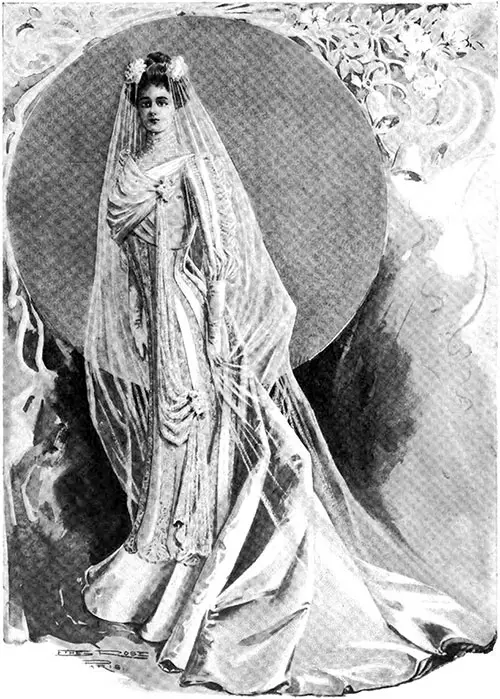
Paris Bridal Gown of White Satin and Point Lace - Drawn by Ethel Rose. Harper's Bazar, 5 January 1901. GGA Image ID # 15ef6a911a
If “the entire world loves a lover,” certain it is, too, that all womanly women are interested in brides and trousseaux. The interest that is bestowed upon brides, in general, seems to be never failing. The trousseau of the present day is, however, a much more sensible affair than that of old.
Young women have wisely concluded that a great mistake was that old-fashioned idea of having a thorough outfit, even if by so doing, the bride were a physical and mental wreck from the consequent fatigue and worry. Those brides of years ago are not to be compared with the present perfectly healthy, contented young woman who has not devoted all the weeks and months of her engagement to laying in a supply of clothes sufficient to last her for years.
Learn More: The Bride's Trousseau - 1912
The original purpose of a trousseau is in itself an excellent one, and that a bride should start on her married life with a sufficient amount of clothing to last for a twelvemonth, no one can question; but it is not necessary to buy clothes for a year ahead, particularly now when fashions change so continually.
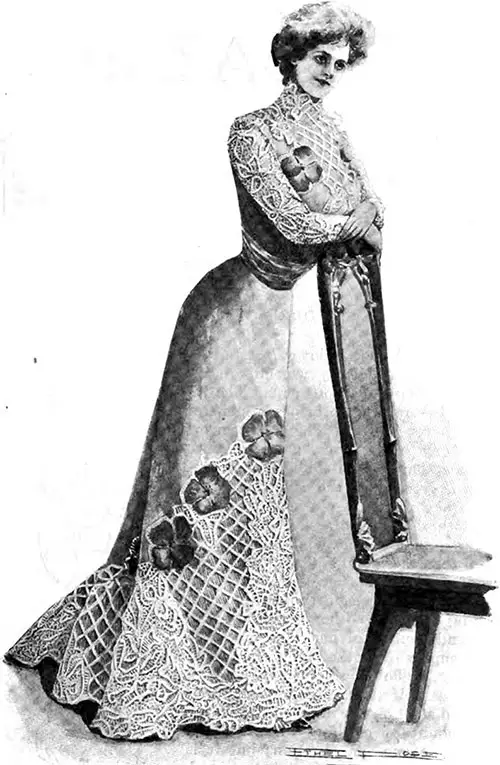
House Gown of Green Peau de Soie With Flounces of Heavy Lace; Appliquéd Figures of Velvet Flowers in Violet Shades. Harper's Bazar, 5 January 1901. GGA Image ID # 15ef9a5378
A sum of money, large or small, as the case may be, put in the bank for the year's expenses, and merely what is necessary for the season of the year when one is married purchased at once, is a far more practical plan.
Sufficient lingerie for some time may be bought, but fashion changes also in lingerie, so that eight, or at the most, a dozen, of everything are all that is required. If one is to live in a large city where there are big shops, it would be folly to invest in any greater number.
The wedding dress should be the principal gown, and whenever it is possible, should be white and worn with a veil, for a wedding dress really marks an epoch in a girl’s life. Never have more gorgeous wedding gowns been seen than this year, for lace is most fashionable, and large quantities of it are employed. It certainly is the most beautiful trimming that can ever be used. White satin is considered the most beautiful material for the wedding gown, a rich, creamy white, and the skirt made with a long train, the exaggeratedly long square train being rather smarter now than the shorter one.
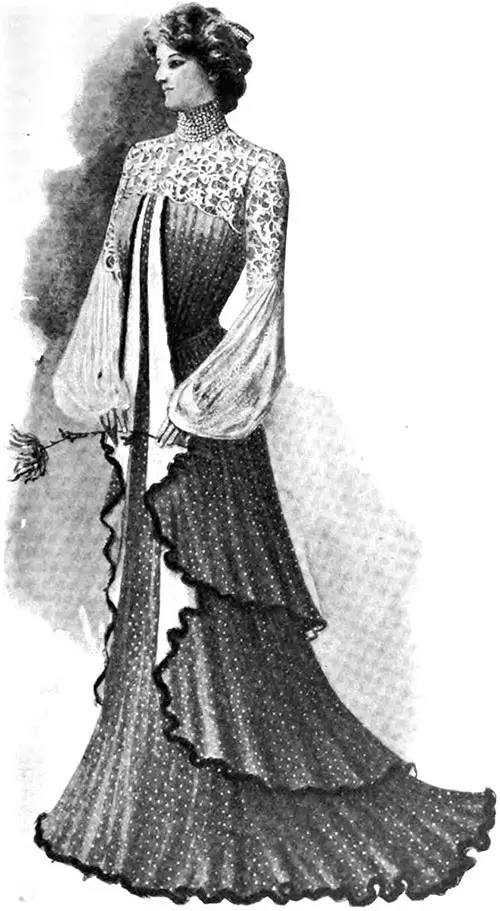
House Gown of Gold Dotted Brown Panné Velvet With Yoke and Sleeves of Cream Lace; Facings of Yellow Satin and Under-Sleeves of Cream Mousseline. Harper's Bazar, 5 January 1901. GGA Image ID # 15efe8e952
The gown is cut high in the neck, although it may have a square neck with lace yoke; the sleeves are long, and the dress is emphatically a high one. White silk of the soft corded quality is as fashionable as satin, although hardly so handsome. The front breadth of the skirt is covered with lace or with lace flounces, the train sometimes finished with a band of lace, but more often it is left plain.
The front of the waist is made with lace bolero or with fichu or draped folds of lace. The sleeves are of lace or of mousseline de soie with lace bands; sometimes of elbow length finished with deep lace ruffles. All the lines of the gown are very simple and made to give as slender an effect as possible.
The traditional point lace veil, the heirloom which every family seems to possess, like most heirlooms, varies very much in size and is not always so becoming or as effective as a much simpler tulle veil trimmed with a band of lace. Tulle veils should be very long, the ends massed on the top of the head under a spray of orange blossoms, and, according to the daily press, fastened with a diamond ornament, “the gift of the groom.”
Diamond crescents and horseshoes seem to express just now the bride groom's feelings of happiness, but it must be admitted that a heavy ornament is not so becoming as the soft tulle rosette with an aigrette or with a spray of the orange blossoms put in at the left side of the knot of hair. The hair should always be arranged high on the head for a wedding, to have the shape of the head look well, as the hair massed under the veil makes the head look thick and clumsy.
It is not fashionable any longer in this country for brides to wear a veil over the face, but this is really a question for each bride to decide. When the veil is worn over the face, there should be a separate piece of tulle pinned in under the spray of orange blossoms. This may easily be removed without disturbing the effect of the veil at the back. The lace veils are arranged in different ways. If the veil is long enough, it is folded in the middle breadth with the folds pleated on the top of the head and thrown back, but if it is short, one end is pleated under the spray of flowers.
White glacé kid gloves are considered smarter than the Suède and should be of the mousquetaire style, the length depending entirely on the length of the sleeve. To avoid the awkwardness of taking off the glove the fourth finger of the glove on the left hand is cut off, but it is very easy to slip the hand out of a mousquetaire glove.
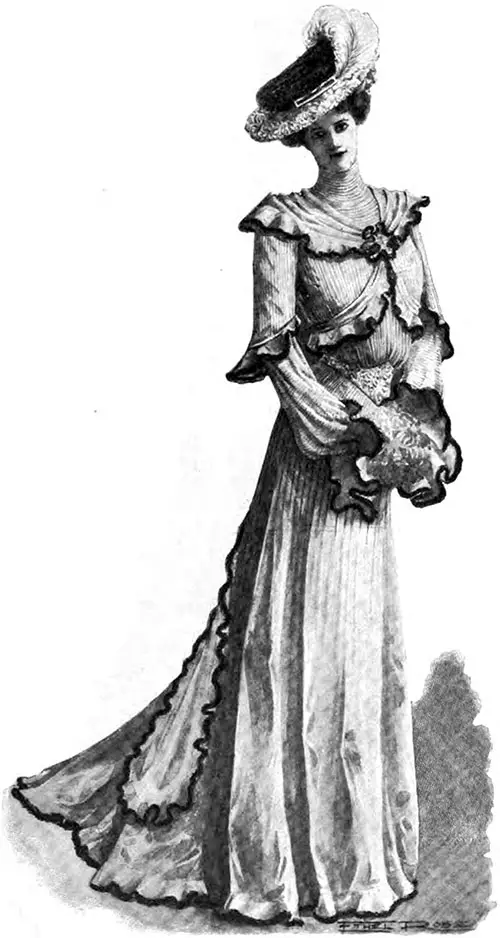
Bridesmaids' Gown of Pink Liberty Satin, Tucked and Accordion-Pleated: Edges of Beaver Fur or Sable; Broad Gold Girdle and Gold Passementerie on Muff and Hat Brim. Harper's Bazar, 5 January 1905. GGA Image ID # 15f0032135
The prettiest bridesmaids’ gowns that have been worn this winter have been made of white lace with sashes and bows of red velvet, and with large hats of the same colored velvet. Yet some of the most effective weddings are those where a color scheme is carried out and the bridesmaids are all dressed in different shades of the same color, in light pink shading to dark, or in the palest yellow shaded up to orange.
Small flower toques or large picture-hats are the most becoming head-gear for bridesmaids, and at present, the large hats are the smartest. Different materials are fashionable for bridesmaids' gowns, but at present mousseline de soie, chiffon, and crêpe de Chine are the favorite materials, trimmed with lace, or, as in the case of a wedding recently celebrated, with embroidery of silver on pale pink Liberty gauze.
When the bride does not wear the conventional white with long veil, a smart costume can be made either of cloth or of silk, with hat to match. Widows do not wear white at their second marriage, but instead, pale gray, and always a bonnet or hat. The button gloves in glacé kid are correct with this style of costume.
It is not customary under these circumstances to have either bridesmaids or maids of honor. For a traveling dress (for, although we read very often of a bride being married in a traveling dress, she rarely wears, to go away, the gown in which she is married) a smart tailor-gown is the best with a long cloak or coat, such as is fashionable this year.
It is a mistake for any bride to start off on her wedding-trip in a conspicuous gown of any kind, but the smart cloth costumes that are now fashionable are most appropriate.
The question is often asked how many gowns are necessary in a trousseau, and the question is about as difficult to answer as “what is the size of a piece of chalk” for the circumstances, and the conditions of life make all the difference in the world.
There should certainly be a smart traveling gown, a silk gown with two waists, a tea gown, a pretty wrapper, a rainy day costume, and a long coat or ulster, with a pretty house gown —not a tea gown, but one that would be suitable to wear to the play. This seems a very medium allowance, but unless a woman expects to be very gay after she is married, it is quite sufficient.
Her wedding dress should be made with two waists, and will, of course, be quite correct for her to wear for all entertainments given for her as a bride. Three or four shirt-waists for ordinary everyday wear, and two smarter waists of silk, satin, or lace for rather more elaborate occasions, will complete an outfit that will meet the needs of most brides-to-be. There should be laid in a good stock of boots, shoes, and slippers, gloves, dainty neck-wear, and all little accessories of the toilette.
It is not necessary that all of a bride's outfit should be new. In many cases, where cost is not a matter of consideration, a large supply of perfectly new underwear and gowns is provided by the forethought of the bride's mother. But the great majority of girls, when the happiest of all times arrives when they are providing for the rose-colored future of married life, find that a certain fixed sum can be spared, from the family bank-account, to supply their needs.
Then come those delightful days of planning, of seeing how well one can make five dollars do the same work that many persons would only expect often; the days of overhauling family stores of old lace and millinery and of old-fashioned family jewels which may be remodeled, and the days of important consultations on the vital subject of lace or embroidery, pink or blue, three gowns or five.
The bride who spends time and thoughts and effort on her trousseau will probably find much more pleasure in using the dainty articles than the apparently more fortunate girl who can order these same things carte blanche.
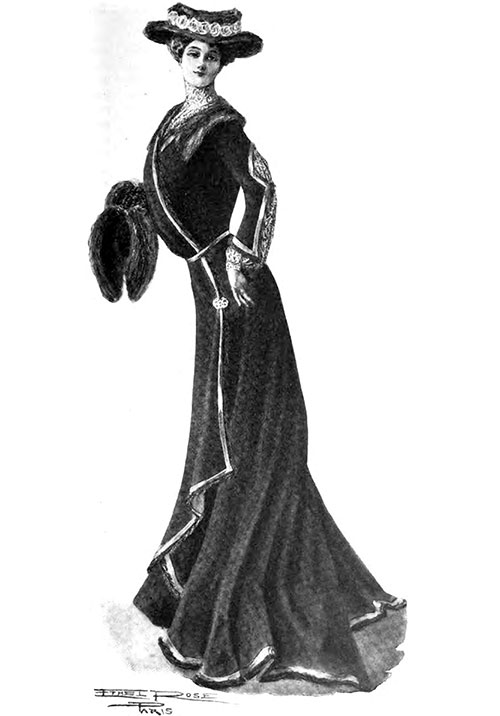
Reception Gown of Blue Velvet; Folds of Maize Satin Edged With Sable; Chemisette and Under-Sleeves of Cream and Gold Lace. Harper's Bazar, 5 January 1901. GGA Image ID # 15f020917b
Brides who are to be married during January or February are having their street gowns and a few for the house made with fur trimmings, and several of these are given in the designs shown here. But the place of the fur may be filled by some other decoration—a binding of velvet or a Ruching of chiffon, or some pretty braid trimming.
The bride's gown shown in the frontispiece is a charming combination of white satin mousseline and lace. The yoke and sleeves are of tucked mousseline, and if desired, this yoke may be made separate from the gown, making it possible to turn the gown into a décolleté for future full-dress occasions.
A princesse over-dress of lace with bands of satin reaches from the bust to the ankles separating at the back for the train of satin to flow out in rich folds. A drapery of mousseline across the back and passing over on the bust ends in a rosette and scarf of point lace. This scarf falls down on to the skirt and is caught with another rosette. The tulle veil is caught either side of the coiffure with a rosette and falls fully to the foot of the train.
Some simple bridal gowns, where one wants to wear white but finds it more practical to have a less expensive gown than satin, are made of white Liberty silk with or without lace trimmings. As a rule, they are not made with long trains.
A. T. Ashmore, "Fashions for Brides," in Harper's Bazar, New York: Harper & Brothers, Vol. XXXIV, No. 1, 5 January 1901, pp. 2-7.
